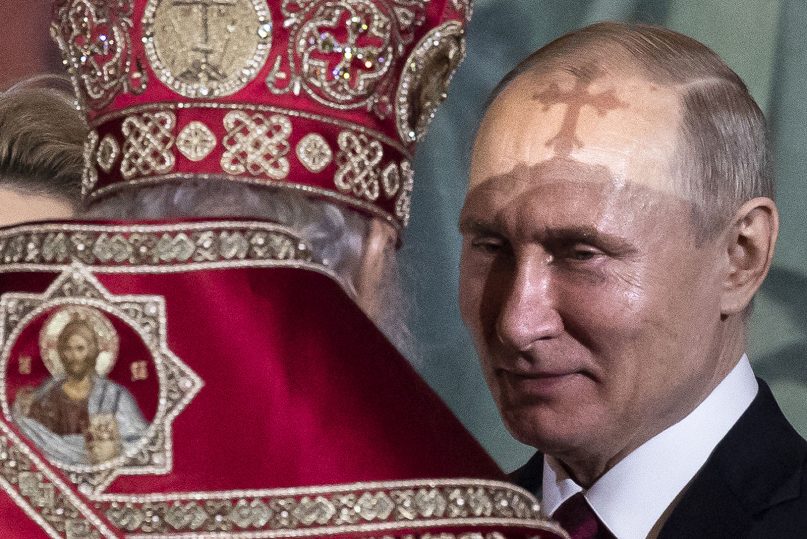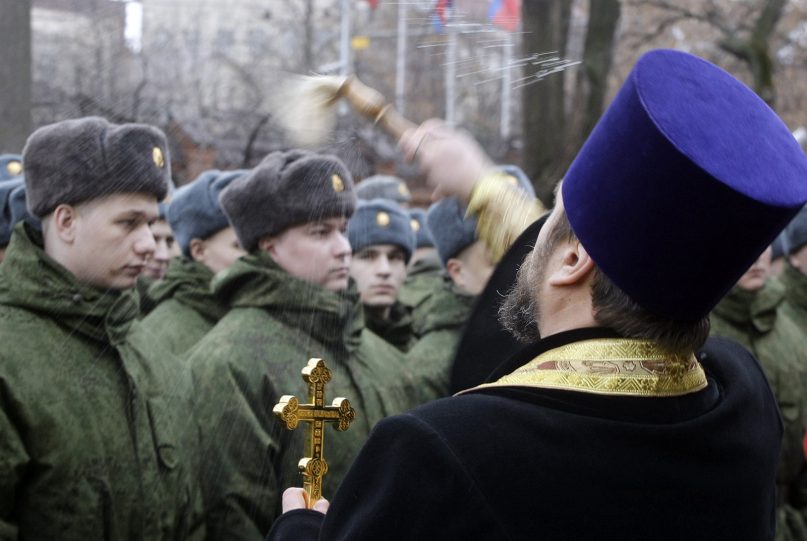It’s somewhat curious, how often Ukraine crops up in the news, usually in a way that’s unnerving.
There was the first impeachment: it centered on this country.
There was the jailing of a key former U.S. presidential aide for criminal ties to oligarchs.
There are the scandals linked to the son of the current U.S. president.
Now, most importantly, Ukraine may once more be ready to go at it with Russia (which also has been the focus of recent scandals, particularly the suspicious murders of Putin opponents, but which also has been in the news for how the Orthodox Church — long under the control of the government — has pervaded the military, even blessing nuclear warheads).
That practice may soon come to a halt. A Church committee has recommended it end. “One can talk about the blessing of a warrior on military duty in defense of the fatherland,” said Savva Tutunov, a bishop of the Moscow Patriarchate. “At the end of the corresponding ritual, the personal weapon is also blessed — precisely because it is connected to the individual person who is receiving the blessing. By the same reasoning, weapons of mass destruction should not be sanctified.”
Christian icons even adorn missile silos. Vsevolod Chaplin, an influential priest and former spokesman for the patriarch, told a newspaper called Vzglyad that nuclear weapons were the country’s “guardian angels” and necessary to preserve “Orthodox civilization.” They see Western civilization as satanic and, keepers of Christianity, are poised for Armageddon. A Cathedral of the Armed Forces has been built near Moscow. The nation’s nuclear weapons have their own patron (Saint Seraphim).
While this is all counterintuitive (the universal Orthodox Church, which is quite different than the government-overseen Russian Orthodox Church), is opposed to nuclear weapons, as is Rome, and while many diplomats, government workers, and journalists are alarmed by the murders or attempted murders of Putin opponents (with everything from radioactivity to clandestine poison), it brings to mind a reputed message in the early days of Medjugorje, that Russia would end up the nation in which God would be most glorified. The question is when that alleged message might be — before or after the end of a government-run Church and the departure of Vladimir Putin (a former KGB agent who U.S. Kreminologists say poses in many roles staged for cameras, from intrepid hunter and martial-arts expert to devout Orthodox adherent).
Right now, Russia is not quite poised to assume the mantle of Christian standard-bearer. Recent alarms have been rung over its moves to control new waterways in the Arctic (as the ice thaws), including with a ship carrying a new super-weapon. Russia also is causing deep concern with its involvement with Syria.
Its competition with the U.S. — and to a lesser degree, with China — remains intense, if often below radar.
More to the point: Will Ukraine and Russia ever cause a nuclear exchange?
They are historic rivals and Ukraine was horribly oppressed as part of the Soviet Union, before declaring independence.
Many believe Putin is seeking to reconstitute the Soviet empire, which could trigger a confrontation with Ukrainian allies, including the U.S. Screamed a London tabloid Saturday: “‘Ready for conflict’: Putin’s threat to the West is laid bare in new footage showing build-up of troops and military convoys on Ukraine’s border as Kiev warns it could be provoked by Russian ‘aggression’ “
Religion historically has been at the heart of oppression. Catholics constitute just .1 percent of the Russian population (“nones” are twenty-five percent and Orthodox 42 percent), while in Ukraine Catholics tally to more than seven percent of the population. The nation was the homeland of Catholic activist and mystic Josyp Terelya, whom the Soviets imprisoned for twenty years and who claimed prophetic visions during apparitions of Mary at Hrushiw, Ukraine, in the 1980s.
One alleged vision was of just such a war. Wrote Terelya: “When the Mother of God looked into the future, she said, ‘I see fire. The villages are burning. Water is burning. The very air is on fire. Everything is in flames. If people do not convert to Christ, there will be war. There shall be a great conflagration.'”
This brought to mind an apparition at Seredne in Ukraine in the 1950s that saw pervasive fire.
But has the Orthodox Church since changed? Other aspects of his messages raised the possibility of Russia being, indeed, a Christian stronghold, though Terelya bitterly opposed the Russian Orthodox Church, which had been controlled by Communists and which he felt was “satanic.”
“If Russia does not accept Christ the King, the entire world faces ruin,” he claimed the Virgin — who appeared to thousands over a small wooden church at Hrushiw — told him. “She said, ‘I see a large field in flames and upon it are many nations. There is not even time to dig graves.
“‘There is no water. The heavens and the air are on fire.
“‘Through you and your martyred Church will come the conversion of Russia, but hasten and pray very much, especially the Rosary.'”
As the manifestations occurred night after night, people prayed and gazed in amazement. “I waited in unreal anticipation,” Terelya had said (during interviews I conducted with him, translated by a priest who later became a bishop). “There was a great feeling of solemnity. Our Lady moved gracefully with the Infant and stood over the dome of the chapel. ‘The Ukraine was the first to acknowledge me as its Queen, and I have received her under my care. I love Ukraine and the Ukrainian people for their suffering and faithfulness to Christ the King. And I shall protect the Ukraine for the glory and the future of the Kingdom of God on earth, which will last for a thousand years.'”
For our discernment.
Ukraine in fact has suffered as much as any modern nation, losing tens of millions during Communist persecutions and Soviet-induced famines.
Have things changed?
We can hope as we attempt to sort prophetic utterances like those from Terelya.
Josyp also saw Russia and China battling along their border at the Amur River.
“All of a sudden a crimson cross appeared over the ocean and the ocean subsided,” Terelya claimed. “The voice of a woman, who seemed to be beside me, said, ‘Lucifer is losing strength. To maintain himself on the throne of darkness, he began to portray himself as repentant, but this is not true.
“Lucifer is cunning and clever. He is preparing a great deception for all of God’s Creation, and especially for the people of God. For a short time a godless kingdom shall maintain itself from one end of the earth to the other.” To his surprise, he saw the one “who has the scales of justice in America.”
At the same time — and complicating matters — he claimed to hear Mary also intone, “In order to save Russia and the whole world from godless hell, you must convert Russia to Christ the King. The conversion of Russia will save Christian culture in the West and will be a push for Christianity throughout the world.”
Is Russia legitimately converting?
It is a question of the hour.
One must pray.
For many prophets have “seen” Russia invading the U.S. (unlikely as that currently may be), and Venezuelan mystic Maria Esperanza once warned that “Russia will act in a surprise way.”
In the end it comes down to two words: Stay tuned…
[resources: Witness: To Apparitions and Persecution in the USSR,” By Josyp Terelya with Michael H. Brown; see also prophecies of Russian invasion in Eyewitness To Heaven]
[Footnote from Foreign Affairs in 2019: “The role of the Russian Orthodox Church in post-Soviet Russian society has been much discussed in recent years, but Adamsky is the first to examine the church’s place in the nuclear military-industrial complex. He details how a formerly persecuted church made itself indispensable to Russia’s nuclear forces by providing them with ideological legitimation as they faced a catastrophic loss of funding and social prestige in the early 1990s. Three decades later, the church has become a prominent presence throughout the entire military, but the nuclear branch stands out as the most imbued with clericalism. Priests regularly minister to its service members, joining their flock on operational missions. The church has built houses of worship on all of Russia’s nuclear bases, Orthodox icons grace nuclear weapons platforms, and commanders have increasingly incorporated religious ideas into their strategic thinking. Adamsky convincingly shows that this began as a grass-roots process, whereby those of lower military rank recognized priests as a source of the kind of pastoral and psychological support they sorely needed in a high-stress work environment. Only later did the regime take notice and seek to systematize the phenomenon from above. The result is an unprecedented nuclear-religious culture, whose emergence has significant strategic implications, including the introduction of theological concepts into Russian military planning.”]



/cloudfront-us-east-1.images.arcpublishing.com/mco/MLGBVE4VSVCDTBMUOUVILUIGXE.jpg)


